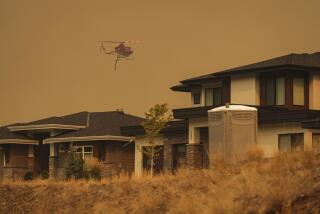23 Feared Dead in Fiery Canada Crash; 46 Survive
DRYDEN, Canada — An Air Ontario jet with 69 aboard crashed into trees and burst into flames shortly after takeoff during a snowstorm Friday, killing up to 23 people, police said.
Forty-six people survived the crash of the Winnipeg-bound Fokker F-28, said provincial police Constable Bill Brayshaw. One person was confirmed dead and 22 others were unaccounted for and presumed dead for after several hours of searching in deep snow and rough terrain.
“There are 22 people we cannot locate,” Brayshaw said. “They may still be in the aircraft. Anybody in the plane I’m sure is deceased.”
Brayshaw said the aircraft caught fire after impact, delaying rescue procedures.
Officials said 65 passengers and four crew were on Flight 363, which originated in Thunder Bay, Ontario. The jet clipped treetops and exploded minutes after takeoff, witnesses and authorities said.
Authorities repeatedly revised the passenger and crew figures, first saying 69 were aboard, then 61 and again 69. Police Sgt. Tom Varga said the revisions were based on information coming from Air Ontario.
Brayshaw said the number of people on board was finally determined from ticket sales. Rescue operations stopped for the night and were to resume at first light today, Hugh Syrja, spokesman for Dryden’s emergency rescue group, said in a phone interview.
The 16-year-old, Dutch-built F-28, a twin-engine jet, took off with visibility about half a mile, said Norm Pascoe, a spokesman for the Canadian Aviation Safety Board in Ottawa.
Survivor Danny Godin said upon arrival in Winnipeg by air ambulance that the plane “was loaded very heavy. . . . We were delayed in Thunder Bay an hour, and we had to take fuel off the airplane because we were above the legal load limit.”
Cuts Wide Swath
The plane cut a swath half a mile long and about 100 feet wide near Dryden, a town of 6,500 people on the Trans-Canada Highway about 200 miles northwest of Duluth, Minn.
Earlier, rescuers hampered by the thickly wooded area and more than three feet of snow used snowplows and chain saws to look for survivors.
Officials said the 46 survivors were taken to hospitals and at least eight were in serious condition. A spokesman at 68-bed Dryden District Hospital, which aided survivors in the lobby and cafeteria, said many of the injured suffered from fractures, burns, bruises and shock.
The Canadian Broadcast Corp. quoted rescue workers as saying the crash occurred in heavy bush country about half a mile off the west end of the runway.
“Most of the people in the very front of the plane did not get out,” Godin said.
He said he felt “the plane quiver as we had an air disturbance . . . (and it) exploded into flames when it first hit the treetops.”
Jacqueline Saville, general manager of the weekly Dryden Observer, said survivors staggered out to a road where they were picked up by emergency crews.
She said rescue crews used snowmobiles to ferry survivors from the crash site.
“You can see smoke from two miles away,” she said. “When it came down, there was smoke.”
Roxanne Groves, a nearby resident, heard the aircraft fly over head.
“It was rumbling really bad,” she said. “It didn’t sound normal and then all of a sudden we heard a thump, a good thump. I looked out about five minutes later and there was black smoke all over the place.”
It was the first fatal crash involving a regularly scheduled commercial airliner in Canada in 10 years. In 1979, 17 people were killed in Quebec City when a Quebecair Fairchild 27 went down.
The worst air disaster in Canada occurred in 1985, when 256 people, mainly American servicemen, died in the crash of a chartered Arrow Air DC-8 in Newfoundland.
More to Read
Sign up for Essential California
The most important California stories and recommendations in your inbox every morning.
You may occasionally receive promotional content from the Los Angeles Times.









